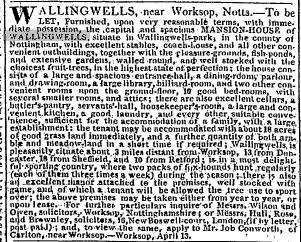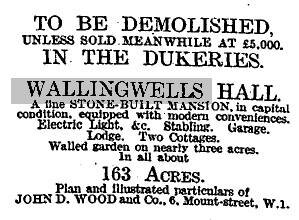Wallingwells
Wallingwells in 1900
This map shows Carlton and Wallingwells, in 1676
In 1847 Woodsetts was converted into a new district parish which included Gildingwells and Wallingwells.
Described in 1852 as situated 4 miles from Worksop, an extra parochial liberty comprising the park and mansion of Sir Thomas Woolaston White, a local magistrate, whose grandfather was created a baronet in 1802. It was part of Carlton parish until the reign of King Stephen when Ralph de Chevercourt founded the Benedictine Nunnery. The house was orginally built out of the ruins of the nunnery, and is a spacious mansion. It is partly in Yorkshire.
In excavating near the house in 1829, several stone coffins were found, one of which contained the remains of Dame Margery Dourant, the second Prioress, who died in the reign of Richard I.
The mansion which stood on the Nottinghamshire side of the woods was, in 1862, the residence of William Windham Coddington, Esq.
The population in 1871 was 26. In 1876, it is recorded that the area consisted of 742 acres, of which 352 acres were in Yorkshire; the Nottinghamshire part in Carlton-in-Lindrick polling district and Bassetlaw parliamentary division, while the Yorkshire part is in Rotherham parliamentary division. By 1881 the population was 32 with five inhabited houses. Parish Clerk was William Cawkwell, Miss Cousins was Schoolmistress at the parochial school which was the property of Sir T. W. White.
For ecclesiastical purposes Wallingwells was attached to the parish of St. George the Martyr, Woodsetts, which was partly in the West Riding and partly in Rotherham Rural deanery.
In around 1885, Wallingwells became a parish by Local Government Board Order, two detached parts of this parish were amalgamated with Carlton-in-Lindrick, and at the same time a detached part of Carlton-in-Lindrick was added to this parish.
By 1904 Thomas Woolaston White was sole landowner, and his mansion was unoccupied.
The children attended school at Carlton, where the nearest Post Office was, some two miles away.
Some of the Yorkshire part of the Wallingwells estate passed from the Gally Knight's

A notice in the newspaper dated 23rd May, 1818 gave details of a mansion to let at Wallingwells.
Mr W. Carr, gamekeeper to Sir T. White was fatally shot in October, 1921.

A notice in the Times Newspaper of August, 1926, announced that Wallingwells Hall along with stabling, two cottages, unless sold for £5000, would be demolished
The Sale was advertised in 69 Lots. Freehold:
The Important Agricultural and Residential Estate of Wallingwells extending to about 3,673 Acres. Comprising the Mansion, standing in a finely Timbered Park, and containing Hall, 5 Reception Rooms, 14 Bed and Dressing Rooms, 2 Bathrooms, Convenient Offices, Lodge, Lake of 12 acres, Modern Stabling and Delightful Gardens. Also 13 valuable mixed Farms, with substantial Houses and Premises, including:
- Corn Hill Farm - 216 Acres
- Cotterhill Woods Low Farm - 213 Acres
- Sunnybank Farm - 145 Acres
- North Farm, Gildingwells - 107 Acres
- Burr's Farm - 142 Acres
- North Farm, Letwell - 300 Acres
- Holme House Farm - 233 Acres
- The Home Farm - 277 Acres
- Lane Side Farm - 70 Acres
- Buckwood Cottage Farm - 99 Acres
- South Farm - 279 Acres
- Langold Farm - 430 Acres
- Haven Farm - 210 Acres
Numerous Small Holdings, Village Occupations, valuable mixed Woodlands, Accommodation Lands, brick earth, important rural and commercial building sites with main road frontages, ripe for development, together with virtually the whole of the village of Letwell, which will be offered by auction (unless previously sold privately) by Messrs. John D. Wood and Co., and Lister-Kaye and Co.
Sir Thomas Woolaston White (1801-1882)
Sir Thomas Woolaston White, son of Sir Thomas Woolaston White of Wallingwells and Elizabeth Blagg of Tuxford, was born in 1801 and married in 1824, Georgina, daughter of George Ramsay, Esq. He married again to Mary, daughter of William Ramsay in 1827. He died in 1882 aged 81 and was succeeded by his eldest son, Lieutenant Colonel Thomas Woolaston White who was born in 1828 and died, unmarried in 1907 at Scarborough.
The family of Sir Thomas W. White are buried at the Church of St. Nicholas at Tuxford.
Read more about the family of Thomas Woolaston White
The owners of Carleton in Lindrick in 1612:
Sir Gervas Clifton, Knight
Sir John Molyneux, Knight
Humphrey Pype, Esquire of Wallingwells
John Buck
Clark,
Robert Glossop
Sam. Simpson.

